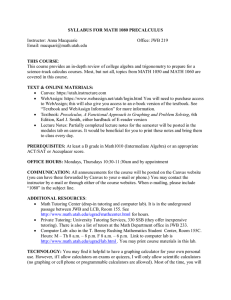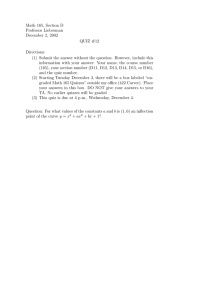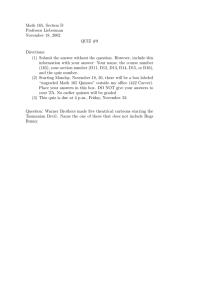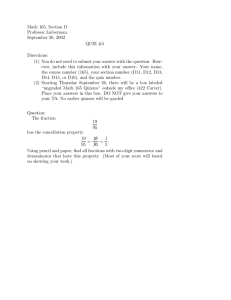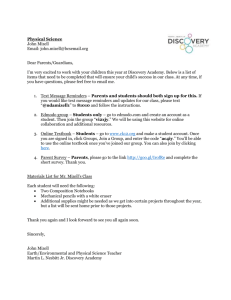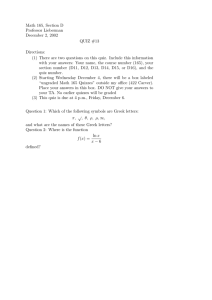SYLLABUS FOR MATH 1080-002 PRECALCULUS Instructor: Anna Macquarie Romanov Office: JWB 219
advertisement
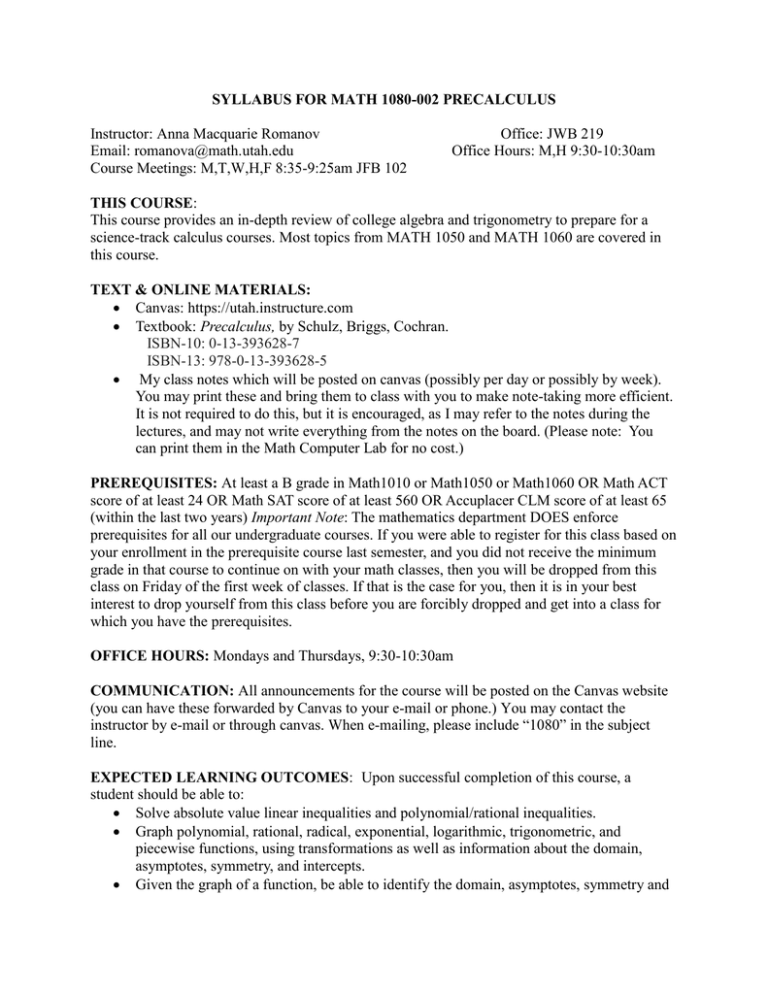
SYLLABUS FOR MATH 1080-002 PRECALCULUS Instructor: Anna Macquarie Romanov Email: romanova@math.utah.edu Course Meetings: M,T,W,H,F 8:35-9:25am JFB 102 Office: JWB 219 Office Hours: M,H 9:30-10:30am THIS COURSE: This course provides an in-depth review of college algebra and trigonometry to prepare for a science-track calculus courses. Most topics from MATH 1050 and MATH 1060 are covered in this course. TEXT & ONLINE MATERIALS: Canvas: https://utah.instructure.com Textbook: Precalculus, by Schulz, Briggs, Cochran. ISBN-10: 0-13-393628-7 ISBN-13: 978-0-13-393628-5 My class notes which will be posted on canvas (possibly per day or possibly by week). You may print these and bring them to class with you to make note-taking more efficient. It is not required to do this, but it is encouraged, as I may refer to the notes during the lectures, and may not write everything from the notes on the board. (Please note: You can print them in the Math Computer Lab for no cost.) PREREQUISITES: At least a B grade in Math1010 or Math1050 or Math1060 OR Math ACT score of at least 24 OR Math SAT score of at least 560 OR Accuplacer CLM score of at least 65 (within the last two years) Important Note: The mathematics department DOES enforce prerequisites for all our undergraduate courses. If you were able to register for this class based on your enrollment in the prerequisite course last semester, and you did not receive the minimum grade in that course to continue on with your math classes, then you will be dropped from this class on Friday of the first week of classes. If that is the case for you, then it is in your best interest to drop yourself from this class before you are forcibly dropped and get into a class for which you have the prerequisites. OFFICE HOURS: Mondays and Thursdays, 9:30-10:30am COMMUNICATION: All announcements for the course will be posted on the Canvas website (you can have these forwarded by Canvas to your e-mail or phone.) You may contact the instructor by e-mail or through canvas. When e-mailing, please include “1080” in the subject line. EXPECTED LEARNING OUTCOMES: Upon successful completion of this course, a student should be able to: Solve absolute value linear inequalities and polynomial/rational inequalities. Graph polynomial, rational, radical, exponential, logarithmic, trigonometric, and piecewise functions, using transformations as well as information about the domain, asymptotes, symmetry, and intercepts. Given the graph of a function, be able to identify the domain, asymptotes, symmetry and zeros, as well as find the formula for the function if it is obtained from a standard function through transformations. Find the inverse of a function algebraically and graphically. Understand and be able to find the domain of functions. Perform composition of functions and operations on functions. Find all zeros, including complex, of a polynomial function. Solve optimization problems involving quadratic functions. Solve exponential, logarithmic, rational, radical, trigonometric, and polynomial equations. Use the Binomial Theorem and Pascal's Triangle to expand a binomial expression. Understand sequences and be able to differentiate between geometric, arithmetic and Fibonacci-type sequences, giving direct formulas where available. Understand series notation and know how to compute sum of finite arithmetic and geometric series. Solve systems of linear equations with matrices, using Gauss-Jordan elimination and inverse matrices. Perform matrix arithmetic and compute inverse matrices. Recognize the formulas for and graph parabolas, hyperbolas and ellipses (including circles). Understand trigonometric function definitions in the context of the right triangle and on the unit circle. Be able to convert to and from rectangular and trigonometric-form coordinates (polar coordinates). Use trigonometric inverses correctly, understanding the domain/range restrictions. Verify trigonometric identities, using proper logic. Solve for all measurements in any triangle, using the Pythagorean Theorem, trigonometric functions of angles, the Law of Sines and Law of Cosines, along with applications. Graph complex numbers in a plane, perform operations on such numbers and use DeMoivre’s theorem to find roots and powers of complex numbers. ADDITIONAL RESOURCES: Math Tutoring Center (drop-in tutoring and computer lab). It is in the underground passage between JWB and LCB, Room 155. See http://www.math.utah.edu/ugrad/mathcenter.html for hours. Private Tutoring: University Tutoring Services, 330 SSB (they offer inexpensive tutoring). There is also a list of tutors at the Math Department office in JWB 233. Computer Lab: also in the T. Benny Rushing Mathematics Student Center, Room 155C. Hours: M – Th 8 a.m. – 8 p.m. F 8 a.m. – 6 p.m. Link to computer lab is http://www.math.utah.edu/ugrad/lab.html . You may print course materials in this lab. TECHNOLOGY: You may find it helpful to have a graphing calculator for your own personal use. However, if I allow calculators on exams or quizzes, I will only allow scientific calculators (no graphing or cell phone or programmable calculators are allowed). Most of the time, you will not have use of a calculator on exams and quizzes. This will be discussed more in class with each quiz and test. If you do not own a graphing calculator, you do not need to purchase one for this class. There are many effective online computing systems that can be used for graphing, such as www.wolframalpha.com. GRADING: Quizzes (10%), Homework (15%), Midterms (50%), Final (25%). There are three midterm exams: the two highest are worth 20% each, the lowest is worth 10%. You should monitor your course grade throughout the semester by looking at “Grades” in Canvas. Please tell me if there are data entry mistakes, so that I can correct them. WEEKLY HOMEWORK Homework is collected on Tuesdays (material through previous Friday) and Fridays (material through previous Wednesday) each week. Each section of homework is worth ten points. For example, if you have three sections of homework assigned for one week, then that homework set is worth a total of 30 points. You will get half credit if you DO every problem. I will NOT be grading for correctness for this half of the grade, so it is your responsibility to make sure you understand the problems and their solutions. This is basically motivation for you to do the homework because that is the only way to survive a math class. (Please notice that there is no way to get an A in this course if you choose not to do any of the homework. On the other hand, turning in all of the homework can help your grade substantially.) The other half of the points for each homework set will be given for correct and neat solutions, with all work shown. The grader will grade a few problems on each homework set to check for correctness. We will not tell you ahead of time which problems will be graded for correctness. The homework is to be turned in according to the following instructions: o For each problem, write enough of the directions so that you know what is being asked, without looking it up in the book. o Staple the homework and write your name and the sections that it covers in the top right hand corner. A homework set turned in without being stapled together or without your name will not be counted. Please have a stapler with you. o 10 late homework sections, up to two weeks late, throughout the semester will be accepted for full credit. Homework more than two weeks late will not be accepted. I accept these late homework sections to allow for illness, oversleeping, hectic schedules, etc. Do not ask for special favors with regard to the homework policy, unless the circumstances are extraordinarily severe. Also, it is not necessary nor recommended that you tell me why your homework is late. This policy is meant to be flexible enough to cover all reasons. o Homework is only collected on Tuesdays and Fridays. If you need to turn in homework late, do so on the next collection day. QUIZZES: There will be a total of 15 weekly online MyMathLab quizzes, which means you'll have a quiz every week of classes, even test weeks. The weekly quiz will cover the material presented that week in class. The quizzes will open on Fridays at 5:00 a.m. and close on Sundays at 11:59 p.m. The quizzes will be timed, so you need to complete them in one sitting. Your lowest two quiz scores will be dropped. MIDTERMS: There will be three one-hour midterm exams throughout the semester, and the dates will be fixed, according to the course outline/schedule that is on canvas. They will be during normal class time, in our usual classroom. FINAL EXAM: The final exam for this class is comprehensive and it will occur on Thursday, December 18th, from 3:30 to 5:30 p.m. GRADING SCALE: The grade scale will be: A (93-100), A- (90-92), B+ (87-89), B (83-86), B(80-82), C+ (77-79), C (73-76), C- (70-72), D+ (67-69), D (63-66), D- (60-62), E (0-59). DATES: Exams: Exam 1: Thurs, Sept 18 Exam 2: Thurs, Oct 23 Exam 3: Thurs, Nov 20 Final: Thurs, Dec 18 Other Dates: Drop date: Wed, Sept 3 Withdraw date: Fri, Oct 24 Last day of class: Friday, Dec 12 Homework: Due Tuesdays and Fridays Online Quiz: Open Friday morning, close Sunday night ADA STATEMENT: The University of Utah seeks to provide equal access to its programs, services and activities for people with disabilities. If you will need accommodations in the class, reasonable prior notice needs to be given to the Center for Disability Services (CDS), 162 Olpin Union Building, 581-5020 (V/TDD). CDS will work with you and me to make arrangements for accommodations. All information in this course can be made available in alternative format with prior notification to CDS. STUDENT RESPONSIBILITIES: All students are expected to maintain professional behavior in the classroom setting, according to the Student Code, spelled out in the Student Handbook. You have specific rights in the classroom as detailed in Article III of the Code. The Code also specifies proscribed conduct (Article XI) that involves cheating on tests, collusion, fraud, theft, etc. Students should read the Code carefully and know you are responsible for the content. According to Faculty Rules and Regulations, it is the faculty responsibility to enforce responsible classroom behaviors, beginning with verbal warnings and progressing to dismissal from class and a failing grade. Students have the right to appeal such action to the Student Behavior Committee.http://regulations.utah.edu/academics/6-400.php OTHER POLICIES: 1. Please be respectful during class. Examples of disrespect include, but are not limited to, reading a newspaper or magazine in class, social chatting with your friend in class, textmessaging during class or cuddling with your girl/boyfriend in class. If I think that your behavior is disrespectful or distracting, I will ask you to leave the class. 2. You may take an alternate exam if you talk to me about it first and explain the emergent, extenuating circumstances that make it necessary. It is 100% your responsibility to communicate with me as soon as is possible, before the exam occurs (or as soon as possible). Talking to me after the problem will be sufficient reason for me to allow you to get a zero on that test. I reserve the right to make alternate exams more difficult than the scheduled exam. 3. If you have crisis-level extenuating circumstances which require flexibility, it is completely your responsibility to communicate with me as soon as possible so I can help you in some manner. The longer you wait to communicate with me, the less I can and am willing to do to help. 4. If you have questions about any exam/quiz/homework grade, or you want to appeal the grading of the exam/quiz/homework, you must bring it to me within one week of the exam. I'm happy to look over your appeal and/or questions and give my feedback in order to benefit your learning. But, it must be done in this timeframe of a week from when I hand back the exam/quiz/homework. 5. You need to read your announcements in Canvas regularly or have them forwarded on to your email address. Individual communication will be sent to your Canvas inbox. You are responsible to make sure you receive all communication that is done through canvas. 6. If you cheat on any homework, project, quiz or exam, I will automatically give you a zero for that grade. Depending on the severity of the cheating, I may decide to fail you from the class. In all cases of cheating, I will also report the incident to the Dean of Students. Additionally, if an international student cheats, I will also report the incident to the International Students Office. 7. I reserve the right to change my policies stated in this syllabus at some point in the semester. If I do make a change to a policy, I will announce it in class and send the change in email. .
